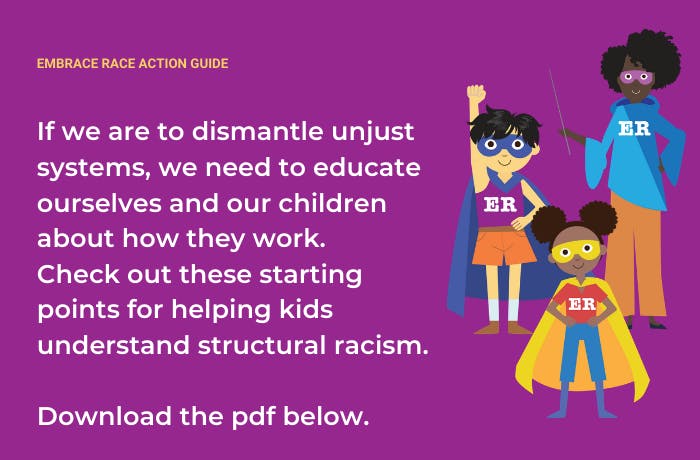Addressing Structural Racism with Children

As a physician and researcher focused on improving the health of underserved and under-resourced populations, I spend a lot of time examining and communicating about how structural factors such as laws and policies impact health.
Adults (especially White adults) often find structural racism difficult to grasp because it’s existence contradicts central American myths such as the myth that we live in a meritocracy and all start on a “level playing field.” If we are to dismantle unjust systems, we need to educate ourselves and our children about how they work. To that end, I wrote The Cycle of a Dream: A Kid's Introduction to Structural Racism in America with my 7-year old daughter in mind. Here are my suggestions for how to approach structural racism with children.
For more, check out the related EmbraceRace webinar, Breaking Down "Structural" and "Systemic" Racism for Our Children.
1) Educate yourself about structural racism.
- For a primer on structural racism for adults, I highly recommend the New York Times 1619 podcast hosted by Nicole Hannah-Jones. In 6 episodes, ranging from 29 to 41 minutes in length, Jones outlines how America has struggled to live up to the ideals of liberty and justice for all. She explores this idea in the context of several facets of life ranging from slavery to health care.
- I also recommend The Sum of Us: What Racism Costs Everyone and How We Can Prosper Together by Heather McGhee. In it, she lays out how racist laws, policies and practices targeting Black people have ultimately reduced the quality of life and economic security of all Americans.
2) Get past your own fear of discussing structural racism with children.
- There is absolutely no scientific evidence that teaching non-White or White children about bias and discrimination harms their self-image when this information is coupled with messages of resilience and discussion of strategies to affect change (Wange et al., 2020; Hughes et al, 2007).
- On the contrary, there is evidence that information on bias and discrimination improves self-image and academic motivation among non-White children (Wange et al.), increases positive perceptions of non-White children, among White children and increases the desire for racial fairness among children, generally (Hughes, 2007).
3) Look for media that supports your efforts to educate children about structural racism.
- Louise Derman-Sparks has a really short and useful guide to selecting books for an anti-racist child-friendly library and I think many of the tips can be applied to selecting television shows as well. She gives practical strategies for recognizing stereotypes, tokenism, invisibility and bias-promoting storylines.
4) Heighten awareness of the historical and contemporary contradictions in American life.
- A content analysis of second grade social studies text books conducted by Mary Fesperman highlights the subtle ways in which a White supremacist narrative is adopted in education. Specifically, introducing American ideals such as democracy, liberty and justice for all to children without pairing this information with a discussion of how America has often not achieved this goal for all citizens has the effect of privileging the experiences of White people and minimizing the impact of racism on non-White people. Talk to the kids in your life about the contradiction of espousing liberty and justice for all in a country that enslaved people. Take it a step further by pointing to contemporary issues such as laws to restrict voting access as an example of how America continues to struggle to live up to desired ideals.
5) Help children be agents of change.
- In this case, the size of the action does not matter as long as it reinforces a child’s agency to promote change. Actions may include but are not limited to speaking out against unfair treatment in their immediate surroundings, attending a protest, funding a cause, volunteering for an event, supporting a business or person that is aligned with anti-racist values or withdrawing support from a business or person that does not share anti-racist values.

Kimberly Narain
Get Insights In your Inbox
Join the EmbraceRace community! You will receive the newsletter with our latest on race & kids, including upcoming events and opportunities, resources, community news and curated links.
Subscribe


